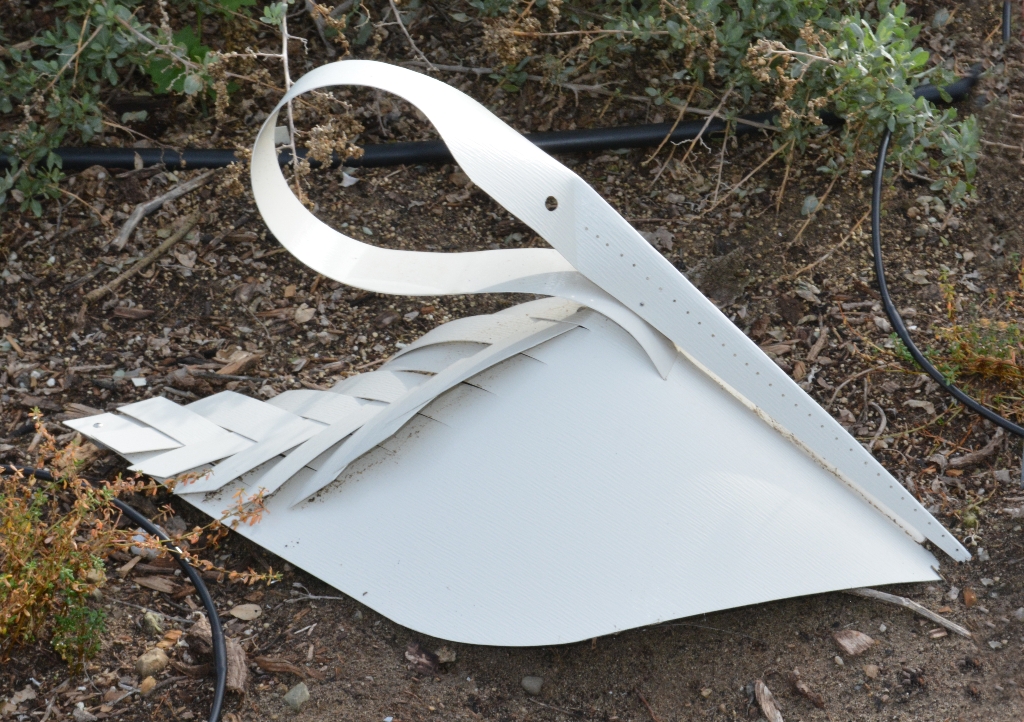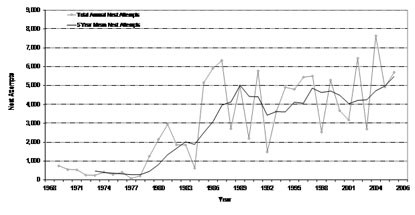
Inspired by the unique wildlife of Channel Islands National Park, BiJian Fan's 3D kinetic, PVC sculptures combine science and art to educate and engage visitors to protect the park.
Garden Art
Inspired by the unique wildlife of Channel Islands National Park, BiJian Fan's sculptures combine science and art to educate and engage visitors to protect the park.
BiJian was born in Beijing, China, where he learned paper art from his grandmother. Today, BiJian resides in Camarillo and still creates paper sculptures, but has also expanded to other materials.
In this exhibit, BiJian artistically transformed PVC into 3D kinetic sculptures of a pygmy mammoth, island fox, bald eagle, and other island species.
BiJian's artwork has exhibited internationally and earned numerous recognitions.
Cailfornia Brown Pelican Natural History
Scientific Name
Pelecanus occidentalis
Introduction
The importance of the Channel Islands National Park for conservation of wildlife is exemplified in its relationship to the California brown pelican. This seabird was classified as federally endangered in 1970 and as endangered by the state of California in 1971, but was delisted as a federally listed species in 2009. The only breeding colonies of California brown pelicans in the western United States are within Channel Islands National Park on West Anacapa and Santa Barbara islands. The preservation of this essential habitat along with the monitoring of this species is critical for the continued health of the California brown pelican population.
Quick and Cool Facts
- Breeding range is from the Channel Islands south to central Mexico.
- The only breeding colonies of California brown pelicans in the western United States are on West Anacapa and Santa Barbara Islands.
- The non-breeding range extends north to Vancouver, Canada.
- Brown pelicans build large nest structures on the ground, in trees, or on vegetation.
- The nesting season can extend from January through October.
- Brown pelicans normally lay three eggs and the adults share incubation duties.
- Brown pelicans can dive from 60 feet in the air.
- Brown pelicans can live up to 40 years old.
- A pelican's throat pouch can hold over 2 gallons of water.
Appearance
Brown pelicans weigh about 8 pounds and measure a little over 4 feet in length, with a wingspan of over 6.5 feet. The 6 subspecies of brown pelican are similar in appearance with slight differences particularly in breeding plumage. Sexes look similar, though males are slightly larger. Brown pelicans have short, dark legs, long, broad wings, a large, heavy all-brown body, and a huge bill. Webbing between all four toes makes the brown pelican an awkward walker, but a strong swimmer. In basic plumage, adults have a white neck and belly, pale yellow head with occipital crest, a brown body, brown eyes, a throat pouch that is reddish orange, and a billface that is paler at the base and tipped with yellow. As the breeding season approaches, the distal end of the bill turns reddish, the proximal end of the throat pouch brightens to a poppy-red, the iris turns a yellowish white to light blue, and a white stripe runs down the pouch side of neck, while the rest of the neck stays dark brown. Colors start to fade during the onset of incubation, and the yellow feathers on the head are replaced with white feathers.
Range
The California brown pelican is a permanent resident of the coastal marine environment on the Pacific Coast and the range extends from British Columbia, Canada, south to Nayarit, Mexico. The bulk of the California brown pelican population (estimated to be about 90%) nests in Mexico. The only long-term breeding colonies of California brown pelicans in the United States are on Anacapa and Santa Barbara Islands. The Channel Islands also provide roosting habitat for the birds, with major roosting areas occurring on offshore rocks of Santa Cruz Island and near the lighthouse on East Anacapa Island.
Habitat
California brown pelicans are aquatic birds and are typically found on rocky, sandy or vegetated offshore islands, beaches, open sea (for feeding),harbors, marinas, estuaries, and breakwaters. Nesting colonies are established on islands without mammalian predators and permanent human habitation. In the Southern California Bight, they typically build a nest on the ground or on native shrubs, but also occasionally in trees. On Anacapa and Santa Barbara Island, brown pelicans generally nest on inaccessible slopes, canyons, and high bluff tops and edges.
Feeding
The brown pelican is the only pelican that is a plunge diver. The brown pelican is a unique feeder that makes impressive dives from ten to thirty above the surface. They are, however, able to dive from as high as one hundred feet. The deeper the meal the higher the dive. When it sees a potential meal it begins to tip downwards, the wings shape into a V, and dives. When the bill touches the surface of the water the pelican will push its legs and wings back creating a bit more force, under the water the bill opens and the pouch stretches out wide allowing the pelican to scoop up fish. The pelicans hit the water with such force that even fish six feet below the surface are stunned. Air sacs throughout the bird's body help to cushion the shock from the dive. Their pouch, attached to the lower mandible, when full can hold up to three gallons of water and fish, it is the largest pouch of any bird in the world. The pelican pops up to the surface, tips their head and bill forward letting the water drain out yet keeping the fish. Then they toss their head back to position the fish head first and swallow. It is said that brown pelicans can eat as much as four pounds of fish in one day.
The California brown pelican stays close to shore and hunts for its food usually within five miles of land. Occasionally, one may travel as far as thirty to forty miles when necessary . Another way they feed is by sitting on the surface of the water and scavenging for food. It scans the ocean for the reflections off of the silvery scales of schooling fish rely solely on the ocean as their food source for they are carnivores and love to eat anchovies (Engraulis mordax). In fact, it is estimated that annually, California brown pelicans off the southern California coast eat about one percent of the total anchovy biomass. During their breeding season 90%of the California brown pelican's diet consists of the northern anchovy. Generally, they feed on this northern anchovy, the Pacific sardine and the Pacific mackerel.
Reproduction
Pelicans breed in nesting colonies on islands without mammalian predators and permanent human habitation. In the Southern California Bight, they typically build a nest on the ground or on native shrubs, but also occasionally in trees. On Anacapa and Santa Barbara Island, brown pelicans generally nest on inaccessible slopes, canyons, and high bluff tops and edges.
Brown pelican are asynchronous nesters.The nesting season historically began in March and extended through late summer or early fall, but in recent years has often surpassed 11 months. Normal clutch size is three eggs. The peak of egg laying is usually March or April; however, eggs are often laid through June. Incubation commences after the first egg is laid, and males and females share incubation duties.
Pelican breeding success is largely determined by the availability of their primary prey items, northern anchovies (Engraulis mordax) and Pacific sardines (Sagax sarinops), which during the breeding season comprise nearly their whole diet. Brown pelicans can be seen performing a surface plunge from as high as 20 meters to catch their prey. Abandonment of nests can occur in years of rapid reduction in food availability.
Brown pelican chicks are naked and helpless and are completely dependent on parental care and protection for the first three to four weeks after hatching. Both parents feed the young until they fledge. In California populations, chicks typically fledge about 13 weeks of age. A high percentage of post-fledging mortality is accounted for by the unsuccessful attempts of the young pelicans to feed themselves.
Migration
Brown pelicans are residents in much of their breeding range. After breeding, flocks move north along both coasts. In the Pacific, they migrate up to British Columbia. In early winter they return south to warmer waters on both coasts. Small numbers of immature birds wander inland in summer, especially in the southwest.
Conservation Status
In the 1960s and 1970s the park's colonies of California brown pelicans faced extinction. In 1970 on West Anacapa Island, only 552 nesting attempts were made and only chick survived. Scientists pinpointed the pesticide DDT flowing from mainland sewers into the sea as the cause. When the pelicans ate contaminated fish, DDT disrupted their reproductive systems. DDT altered the birds' calcium metabolism, resulting in egg-shell thinning. The egg shells were so thin that they broke under the parent's weight resulting in reproductive failure.
The federal government listed the brown pelican as an endangered species in 1970, the state of California listed it as endangered in 1971, and DDT was eventually banned in 1972. The fight to save these birds led to a remarkable recovery. The park's breeding populations have steadily increased since 1980 and this subpopulation is now believed to be fairly stable. On Anacapa Island from 1969-1984, average colony size was 900 nest attempts per year.Strong increases in both productivity and nest attempts were observed in the mid 1980s, and the Anacapa colony has produced a mean of 4,600 nests per year during 1985-2006.
Pelicans did not nest on Santa Barbara Island in recent times until 1980; the first significant nesting occurred in 1985. From 1985 to 2001, the colony produced a mean of about 770 nests per year. Starting in 2000, the pelicans started moving their nesting area around on the island.

Today, the pelican population on West Anacapa Island averages about 4,600 nesting pairs annually and on Santa Barbara Island the average is about 1,500 nesting pairs.
Nesting and roosting birds are very sensi¬tive to human disturbance. Pelicans are affected by ancillary fishing activities, including the presence of vessels, noise, and lights, near roosting and breeding areas. Increased light levels are known to alter the behavior of pelicans, leading to nest abandonment and increased egg and chick mortality. In 1999 large increases in nighttime squid fishing activity on park waters probably affected nesting pelicans - higher than average rates of nest abandonment and chick mortality were recorded and could not be explained by other environmental factors.
There is no visitor access to West Anacapa Island. A no-entry closure from January 1 through October 31 also keeps boats well offshore to protect fledglings in the vicinity of the nesting colony and provides a buffer zone to nesting pelicans. On Santa Barbara Island, the pelican nesting area is closed to visitors and trails are closed when birds are nesting.
In 2009, the brown pelican was removed from the Federal List of Endangered and Threatened Wildlife due to recovery. This action was based on a review of the best available scientific and commercial data, which indicated that the species is no longer in danger of extinction, or likely to become so within the foreseeable future. The brown pelican remains protected under the Migratory Bird Treaty Act.
Additional Information
National Audubon Society
Is there something we missed for this itinerary?
Itineraries across USA


















































